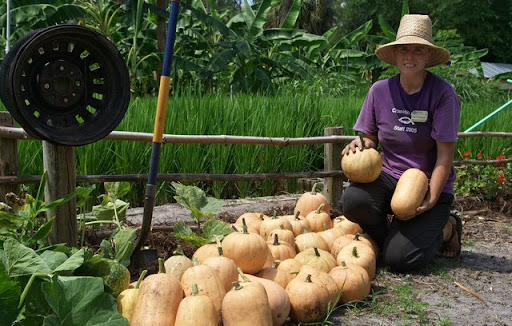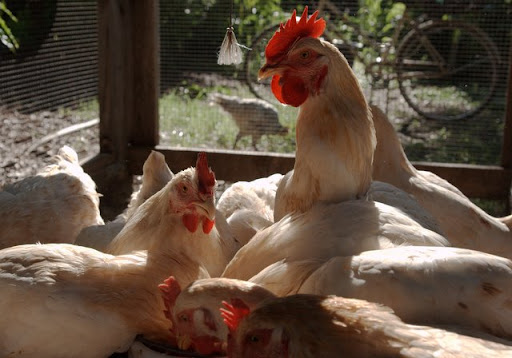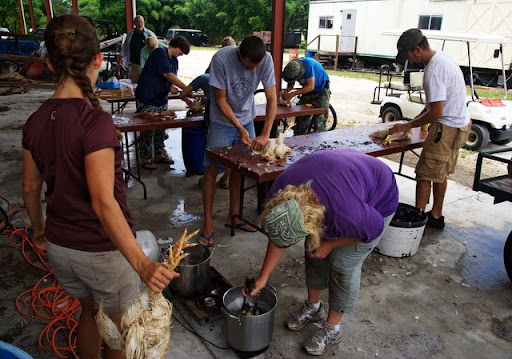These past few weeks I've had the privilege of doing a lot of weeding in the sweltering Florida sun which, when combined with the torrential Florida rains, makes weeds magically appear overnight. Weeding is, incidentally, a great chance to ruminate on philosophical cellulose, and I've been noticing a lot of similarities between weeds and another subject I struggle with, namely sin. So here's a list of 7 ways in which weeds are like sin.
1. Most weeds aren't inherently bad: it's all about context.
As a horticulturist it is easy to see just two categories of plants: "good plants" and weeds. The former are encouraged, the latter expunged on sight, from every pot, in every context. Dandelions aren't part of a well-kept lawn; therefore, any self-respecting home gardener develops a distaste for them and dutifully sprays, pulls, or curses them out of existence. Never mind that they have pretty flowers or taste good in salad. If they're sometimes a weed, they're always a weed.
[3], and realized that most of the weeds I was pulling out, many of which were quickly outpacing the vegetables I had planted, were both edible and nutritious. In an environment where getting plants to grow at all is a daily challenge, it seemed insane to be fighting delicious, productive plants in favor of spindly vegetables just because I didn't plant the "weeds."
One oft-quoted definition of a weed is "a plant in the wrong place." This is still one of the best definitions I've come across. All plants have some value: if not in their fruit, then in their aesthetics or their ability to cycle nutrients, provide food and habitat for animals, serve as a living mulch, and so forth. In the right context, then, every plant has a place, and becomes a non-weed. This means that a weed in my garden might not be a weed in my neighbors, and, more applicably, a weed in my own garden might cease to be so if I recognize its value and cultivate it in such a way that it complements, rather than destroys, the rest of my garden.
The purslane on my chicken coop? For now, it stays.
2. If you ignore weeds long enough, they will destroy your garden.
 |
3. The war on weeds is won before they come to fruition.
When the time came to take over the rooftop garden from my predecessor Kim, I wrote down a list of principles and practices for myself to guide my care of the garden. One of the first strategies I penciled down was this: Don't let weeds flower. I can't catch every weed the day it germinates, much as I'd like to. But if I don't catch them the day they flower, every weed I miss will mean a dozen new weeds next spring, and every spring thereafter until the soil seedbank is depleted. There's no doubt: making the time investment now is totally worth it.
4. You can't just remove weeds; you have to replace them.
There's a large truck tire in front of my rooftop chicken coop that probably used to overflow with vegetables. Since I got here, it has stood empty. Or rather, it has stood full of weeds. While I was concentrating on developing the other end of the garden, I let my chickens out for a few weeks to weed this and other empty beds around their coop, which they did admirably. Now that the chickens are back to being confined to their cage and I still haven't planted anything in the tire, the weeds are back in full force. It really doesn't matter if I weed them... they'll be right back, and will keep coming right back, until I cultivate other plants to replace them.
 |
Weeds seem to thrive in a vacuum. Compare that tire with the one on the right, which I haven't had to weed once!
5. Mulch and a healthy crop combine to stifle weeds
You know what's easier than fighting weeds? Not letting them fight!
After the first few weeks of pulling out weeds just before they flowered, I realized that new ranks of weeds were quickly replacing the ones I was removing. So quickly, in fact, that I knew that if I kept fighting them at this level, I'd be exhausted in no time. Anywhere sunlight hit soil, weeds appeared out of nowhere like mushrooms after spring rain.
 |
This is so much easier!!
6. The goal of a garden is not to reduce weeds. The reason we reduce weeds is so that we can garden.
I love gardening. This makes removing weeds well worth the considerable effort. And because weeding is not the point, but gardening is, the following truth becomes completely okay:
7. Complete weed freedom is unattainable on this earth. Rejoice in progress and small steps.
It's fascinating that the Genesis narrative cites man's rebellion against God as the source of both sin and weeds. And just as our sin has turned out to be beyond our human capacity to eliminate, so weeds and invasive plants will be our constant companions as long as this earth remains. But the knowledge that both are conquered, that God will restore both us and the rest of creation to a fullness we've all but forgotten, means that neither our weeds nor our sin need be causes for despair. Which is good, because I still have a lot of weeds!
So my question to you is not "Do you have weeds in your garden?" but "If I visit your garden, will I find you there?" I hope so!
---
[1] Ecologists would use the term "invasive plant," a term that carries less value but, usually, the same sentiment.
[2] Or at the very least, ancient religious poetry.
[3] Yup, I'm growing food on top of my chicken coop. Gotta maximize space use efficiency in an urban context.

























.JPG)





















